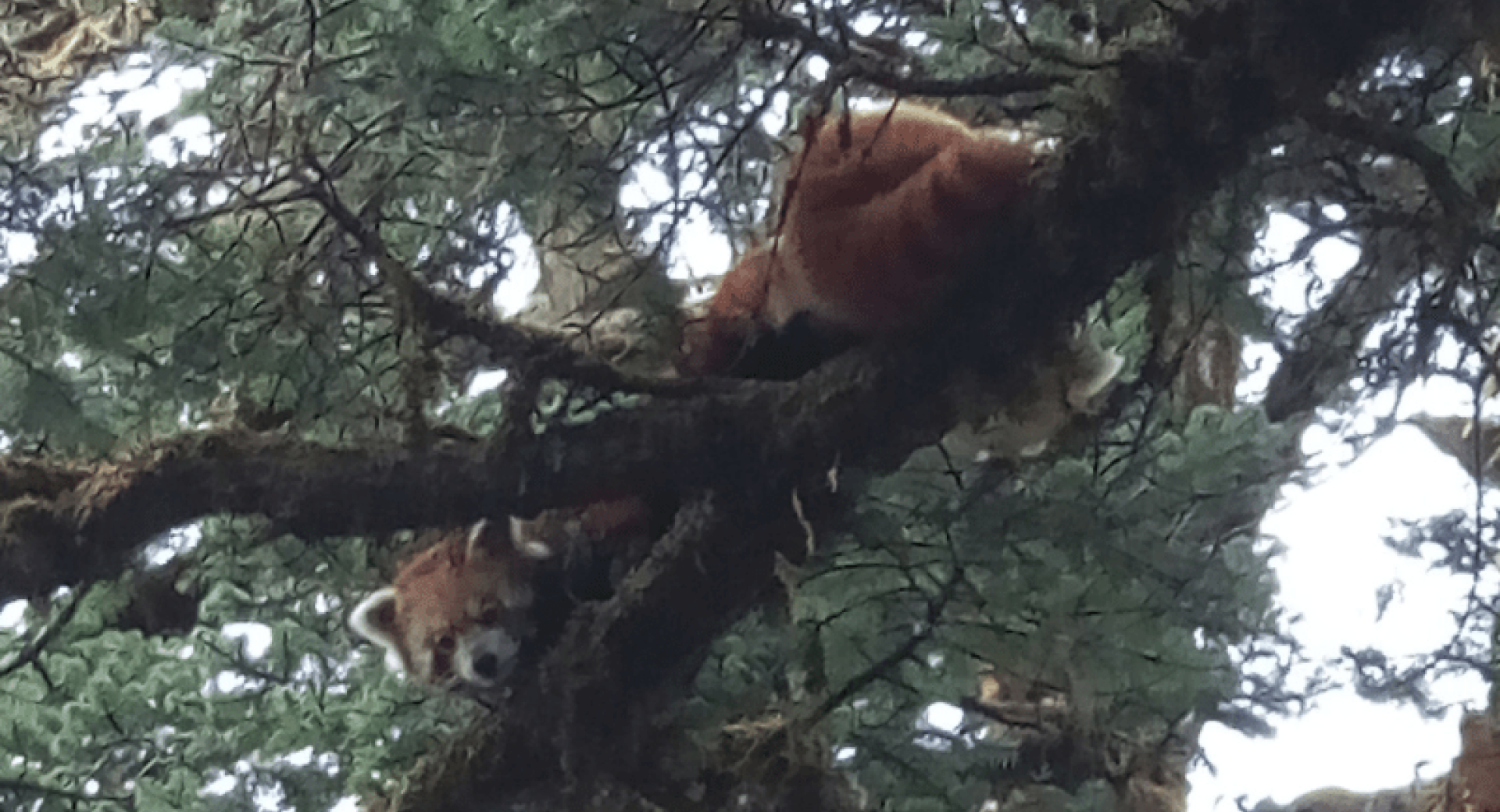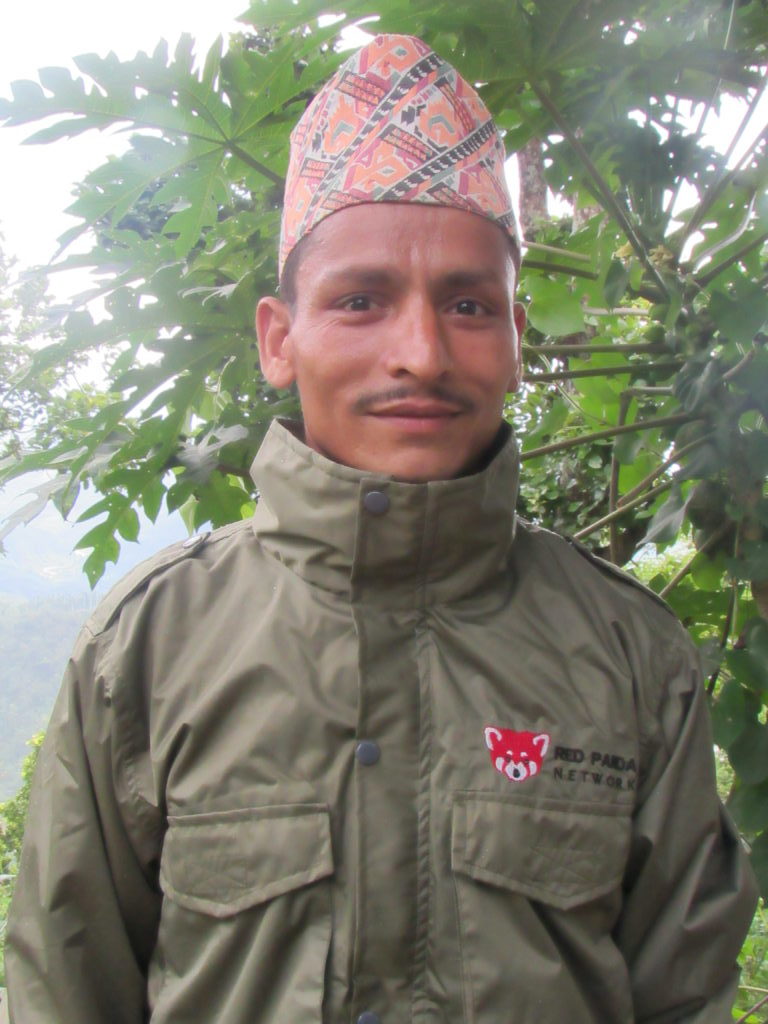
FOREST GUARDIAN, KAMAL NEPALI, PHOTOGRAPHS FIRST RED PANDAS SINCE RPN'S EXPANSION TO WESTERN NEPAL.
On the morning of November 22, 2018, RPN Forest Guardian, Kamal Nepali, and his wife, were walking in Sankadaha Community Forest of Jajarkot district, Western Nepal. A cold breeze was blowing as sunlight pierced through the canopy of mixed pine, rhododendron, and bamboo understory. Suddenly, a pair of red pandas appeared on a giant Gobre Salla tree.
“It was a big surprise. I instantly took out my mobile phone and tried to take a picture but it was hard to get a shot from where I was standing. So I climbed a tree and took the picture,” says thirty-year-old Nepali, one of eight Forest Guardians selected in Jajarkot district by Red Panda Network (RPN) to monitor red panda habitat in the area. The picture taken by Nepali is the first photographic evidence of red pandas in Western Nepal since RPN launched community-based programs there in 2017.
Nepali, a local from Mulsam—a remote and western village of Jajarkot district— joined RPN’s Forest Guardian (FG) program about five months ago. On the day when the red pandas were photographed, Nepali was visiting the Community Forest as part of red panda habitat monitoring conducted four times a year by FGs in the area.
“I come from a very poor family and lost my father when I was a child. I grew up hearing stories of barking deer, Himalayan Thar, wild boar and other wildlife found in the area. Locals had no idea what a red panda is and believed it to be a common cat species,” shares Nepali.
According to him, locals often shared stories about the cat-like species but were not aware of its endangered status until a year ago. “They (locals) had negative emotions towards red panda,”
People’s attitude towards the ‘unknown’ red panda started changing gradually, thanks to the launch of community-based red panda conservation initiatives in Western Nepal. RPN’s efforts began in Jajarkot and Jumla districts in November of last year with the help of local partner’s Danfe Youth Club and Karnali Development Cooperative Service Society. Kalikot, another mountainous district bordering Jumla and Jajarkot, was added to the project in February of this year. Under this three-year project, RPN will work with local communities to improve forest cover and protect water sources in red panda habitat areas.
 Forest Guardian, Kamal Nepali
Forest Guardian, Kamal Nepali
“I feel happy talking to villagers about red panda and why they need to protect it. They have now realized the importance of having red pandas in their area and show willingness to protect them and their habitat,” Nepali said, adding, “I tell them that if they protect forests the number of red pandas will increase and more people will visit our place to see them. This will contribute to the local economy and they are happy knowing this,”.
Rich in forest cover and biodiversity, Mulsam is located in a remote region of the mountainous country; it takes three days to reach it on foot from the district headquarters as there are no roads connected to it. Poverty is rife in Mulsam with sanitation and hygiene ranked among the worst in the country. Every year during the rainy season, many villages—including Mulsam—witness diarrhea outbreaks.
“There are multiple problems faced by the locals here but still they are showing interest in red panda conservation, which is praiseworthy,” says Bhup Lal KC, Conservation Officer, RPN in Jajarkot district.
According to KC, Jajarkot has good forest cover—some managed by the government and some by the local community— which is comprised of Pinus and rhododendron species. Non-timber forest products and medicinal plants are also abundant in Jajarkot district.
“The increased demand for medicinal herbs has led to the haphazard and illegal collection of medicinal plants that has also led to illegal logging inside both national and community-owned forests. This has caused disturbance and fragmentation of red panda habitat,” KC said.
Before joining the FG team, Nepali worked in India as a mason. After the devastating 2015 earthquake in 2015 in Nepal, Nepali returned to build earthquake-resistant houses in Dhading, one of the most earthquake-affected districts in Nepal.
“I worked as a mason for more than one and half decades both in Nepal and India. I am always ready to help the community and now it is my job to protect red panda and I am confident that my people will support me on this mission,” he said.
